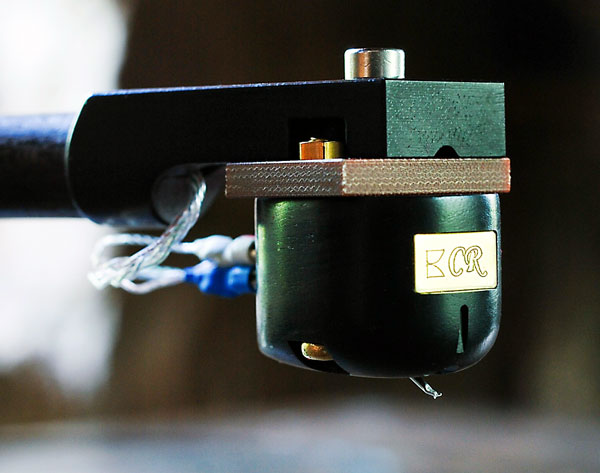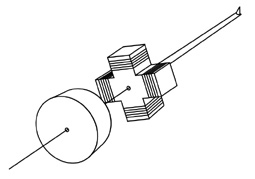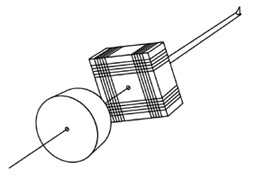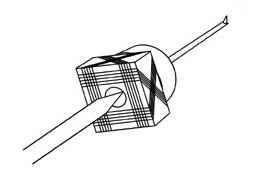It was about late in 2010 that Constantine brought me the Miyajima Premium BE mono cartridge back from the RMAF. It was my privilege to listen to music through this exceptional phono cartridge as well as reviewing it. When I found out that William Demars of Beauty of Sound was sending me the Ikeda IT-407CR1 tonearm to review, the first phone call I made was to Robin Wyatt to see if he could send me a Miyajima Shilabe to review in the Ikeda tonearm. I want to thank Robin for sending one out to me for this review and to use in my review of the Ikeda tonearm.
Description, Installation, Use, and Tracking
The Miyajima was a breeze to install even though the cartridge isn’t threaded. It comes with screws that have to go in from the bottom and the small nuts go on the headshell. The cartridge pins are sturdy and easy to get to, and best of all, it has a stylus guard. It was very easy to mount on the headshell of the Ikeda tonearm. The cartridge weighs 10.4gm. and is a low-compliance moving cartridge designed to track between 2.5 and 3.2 grams. I found 3.2 grams sounded best in my system.
This cartridge has a large-diameter, old-fashioned, bigger-looking cantilever to which a Shibata stylus is attached. In their literature it says, “I use the cantilever which is bigger than a thing used generally for the cartridge of the product. The reason is … that a cantilever bends at the time of reproduction when I use a thin cantilever.”
Of course, being a Miyajima cartridge it uses their patented “cross-ring” construction. This means that the generator’s fulcrum or pivot point is centered within the coil so that every movement of the cantilever provides an instantaneous signal. It also means the left- and right-channel coils are wound in a pattern of overlapping ellipses very much like the crossing rings in a gyroscope.
The Shilabe’s 16-ohm impedance and 0.23mV output is an unusual combination which complicates the choice of step up transformer to use. I tried both my Auditorium 23 SUT, the Homage T1 and the one designed for higher impedance moving coils. In the end I used the new 3440 AH Blue Version SUT from Bob’s Devices, which has the right impedance and has a toggle switch to select the amount of output.
The innovativeness of the Shilabe comes from Mr. Noriyuki Miyajima’s different placement of the coils. In most moving coils available on the market, the cantilever has the diamond on one end and coil on the other. Between the coil and the magnet, there is a shock absorber made from rubber and silicon. Not the best solution, because, as you can see on the drawing, the axis of suspension of the coil and sweep is not in the center of the coil, but shifted to the back. The moving coil has to overcome the resistance of the wire, which diminishes the sensitivity and increases the inertia of the suspension. In addition, the coil wound around an iron core has to overcome additional attraction generated by the core’s strong magnetic flux.
Miyajima uses another solution, in which the cantilever is supported on a pin coming from the back magnet and tightened to the front yoke. Here the absorber is placed between the coil and the front yoke. The clear asset of this solution is the support point for the cantilever, which is exactly in the coil’s axis, and thus allows for more effective transformation of the movements to electric current supposedly. Miyajima claims that this kind of suspension does not introduce additional resistance and has much lower inertia. The core of the coil is made from resin, which does not interfere with the magnetic flux and does not introduce additional distortion.
Sound
Like all cartridges, the Shilabe needs some time to break in and stabilize. It sounded really good right out off the bat, but after playing for about 40 hours it seemed to have settled into just plain wonderful; what transparency, speed, micro-dynamics, and startling aliveness it has.
Like some other components I have reviewed, the Miyajima Shilabe defies being broken down into parts. It misses the point to waste time talking about the midrange, bass, soundstage, or other audiophile stuff. Listening to music played by the Shilabe is astonishingly enthralling and emotional. The way it handles space is right on. I’m not talking just about the typical audiophile soundstage but a coherent, whole soundstage that still lets you hear individual instruments or voices in their own space as well. It may not be the deepest and widest soundstage you can get, but again I think it handles space in a way much more like live music.
Well, I could never write a review and not talk about voices. It’s ultimately how any component reproduces the human voice that makes it or breaks it for me. I can’t say that I often thought about the voices when listening to the Shilabe, though it plays voices about as well as any source I have heard; I was too busy listening to the performance, not the sonics.
Part of what makes the Shilabe so musically involving is that the timbre and tonality are near-perfect. It allows you to hear the different colors and hues that make music so beautiful. Instruments and voices have very nice body with plenty of natural air around them. It also reveals the kind of inner detail that allows you to hear deep into the music. I think this has a lot to do with why you are able to experience so much of the emotions of live music.
Comparisons
I listen mostly to the Shindo SPU though I also listen regularly listen to an EMT TSD15 and my EMT mono cartridge. The general character and tonal balance of the Shilabe cartridge is slightly different from my reference Shindo SPU. It’s a high resolution sound, the Shilabe has transients that are as fast and quick as any cartridge I have heard, yet there was nothing edgy or bright about the Shilabe’s sound. It’s not quite as full-bodied as the Shindo, nor does it have quite the power of the EMT, but it cuts a clear path between the two.
The Shilabe is a superbly coherent cartridge from top to bottom, but weighted toward the upper midrange and treble in comparison to the Shindo. The Shilabe has a little more slam and a little less fullness in the bass than the Shindo. Compared to the EMT TSD15 it has a little less slam and a little more warmth. It’s only in micro-dynamics that the Shilabe falls short of both cartridges, but it is by the slimmest of margins.
For example, the Joan Baez Live album is one of my go-to albums. She sounded in rare form with the Shilabe in the system. Her voice had all the nuances that make the female voice so beautiful to listen to. You can hear her range, her breath, her phrasing.
Ry Cooder, Jazz – This is one of those recordings that I have enjoyed for years. I was introduced to it by Mike Shots years ago when he owned the Soundtrack in Auburn, Alabama. It is an album full of fun music, with lightening-fast transients, fast bass, and strong vocals. Again, the Shilabe held its own with any cartridge I have ever heard with this great LP. The leading edges of the transients were world-class and the decay was better than some cartridges that cost at least twice as much.
Another recording I use in every review is Ella and Louis. On the right system, cut 2, “Isn’t This a Lovely Day,” let’s us hear Ella in all her glory and then Satchmo seems to be right in the room with you. This was exactly what happened with the Shilabe in the system. It was especially beautiful.
I know Evita isn’t thought of as an audiophile recording by any stretch of the mind. Still, it is a wonderful musical experience especially on vinyl. On the opening of side four, there is a children’s choir. These delicate voices are reproduced clearly, and with such beautiful harmonics that it is truly lifelike. The phrasing of the singing actors is so precise that it comes across like they are just a few feet from you.
Conclusion
The Miyajima Shilabe is very true to fidelity. The sound is very lyrical, and allows for the many moods and emotions of music. It has a very vivid sound, but still you can listen to it for long periods of time without any listening fatigue. (Also see Phillip Holmes’ August, 2010 Review of the Miyajima Shilabe. -Pub.)
U.S. Importer’s Comment:
Thanks to Jack Roberts again and to Dagogo. I have one comment, in the review Jack mentions the Bob’s Devices Step Up, the 3440 AH Blue Version. The new Cinimag CM1131 unit would address Jack’s observation of a slight lack of bass, and “sat on” dynamics. I like my Shilabe loaded at 1k the transformer makes that hard to achieve, but that setting allows full bandwidth with subterranean bass, with amazing balance.
Again thank you guys. Constantine keep up the great work!
Robin Wyatt
- (Page 1 of 1)




